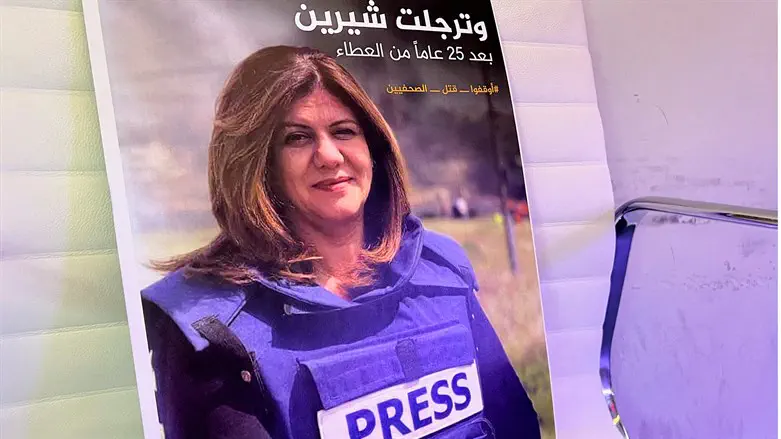Ballistic expert to INN: IDF didn't kill Al Jazeera journalist
Renowned physicist and ballistician Nahum Shahaf insists: The bullet that killed Shireen Abu Aqleh was not the IDF's doing.


Leading physicist and ballistic expert Nahum Shahaf, who refuted the story of 12-year-old Muhammad al-Durrah being shot by IDF soldiers in the opening days of the Second Intifada, discussed the US State Department's announcement that it was not possible to determine who killed Al Jazeera journalist Shireen Abu Aqleh as she was recording a firefight between IDF soldiers and terrorists in Jenin on May 11, 2022.
Shahaf points out that "the bullet underwent a severe transformation at the hands of a hammer that created a deep depression in its back, which cannot be formed by the projectile's movement alone", noting that while the Americans ruled that it was impossible to determine who was behind Abu Aqleh's death, they ended up stating that it was likely the result of IDF fire - a fact pointing to the investigators' anti-Semitic bias.
According to him, the tests performed on the bullet were administered by technicians and engineers who usually deal with standard tests similar to those performed in the forensic field. "While there are some world-class experts at their forensics labs, most of the staff are your everyday practitioners so you can't expect them to be equipped to deal with these kinds of complex issues," he states.
"I conducted an experiment that made it possible to restore the original bullet. I've been advised by an expert source in the IDF but can't reveal his findings before he fully authorizes them himself," says Shahaf. At the same time, he insists that just about anyone can tell that the PA's claims are entirely manufactured.
"The [PA] claimed that Shireen was shot by a Roger rifle, a sniper rifle used by the IDF, a 0.22-LR-type which employs reduced energy and power, and is considered non-lethal at a distance of over 100 meters. In this case, however, the bullet not only penetrated her spine but completely dismantled her lower jaw. I have seen the horrible image of what happened to her. The Roger rifle could not have done that. This is a rifle known to be non-lethal at such distances, and certainly could not have destroyed her face like that. A wound like that requires a very strong bullet moving at a very fast pace."
The obvious conclusion for Shahaf is that: "the bullet was fired from a different and [more] powerful gun. "The Palestinians themselves were quoted as saying that the bullet came from a Roger rifle," he insists.
Regarding alterations made to the bullet prior to the PA allowing foreign experts to analyze it, Shahaf says he can detect streaks of crushing as well as an internal depression, which can only be produced by a hammer of enormous weight. The squeezing in question was performed on the back of the bullet and not its front, which smashes on impact.
The fact that the American findings received the support of Israeli forensic experts doesn't sway Shahaf, who reminds us that he was the one responsible for the inquiry into the al-Durrah affair "and not the ballistic experts or police" who also took part in it "because that is not their field of expertise." "You can't ask someone who does not know how to develop a certain weapon to be able to solve an unconventional problem of this nature," he adds.
Asked whether the transformations wouldn't be recognizable by someone with a minimum amount of knowledge, he says that, "Sometimes there's no way of having people notice things without pointing them out yourself."
Shahaf concludes that Abu Aqleh "must have been shot from a heavy rifle like the Kalashnikov." He avoids making a determination that the weapon used was indeed a Kalashnikov, however, so long as it hasn't been tested using IDF equipment. He says that a very senior IDF expert has taken upon himself to analyze the bullet and has already received the necessary materials to carry out the investigation.
The long-time expert suggests that the IDF should form a special committee consisting of experts from various fields tasked with carrying out an in-depth analysis of the events leading up to the journalist's untimely death, allowing them to shed light on what really took place the day she was shot.

.jpg)
No comments:
Post a Comment